Draft:Johnson solid list
| Submission declined on 16 August 2024 by Hey man im josh (talk). Thank you for your submission, but the subject of this article already exists in Wikipedia. You can find it and improve it at Johnson solid list instead.
Where to get help
How to improve a draft
You can also browse Wikipedia:Featured articles and Wikipedia:Good articles to find examples of Wikipedia's best writing on topics similar to your proposed article. Improving your odds of a speedy review To improve your odds of a faster review, tag your draft with relevant WikiProject tags using the button below. This will let reviewers know a new draft has been submitted in their area of interest. For instance, if you wrote about a female astronomer, you would want to add the Biography, Astronomy, and Women scientists tags. Editor resources
|  |
 Comment: This topic exists, and is a featured list, at List of Johnson solids. Hey man im josh (talk) 16:17, 16 August 2024 (UTC)
Comment: This topic exists, and is a featured list, at List of Johnson solids. Hey man im josh (talk) 16:17, 16 August 2024 (UTC)
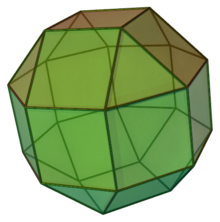
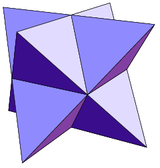
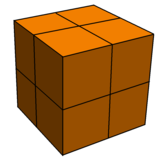
In geometry, a Johnson solid is a strictly convex polyhedron each face of which is a regular polygon. There is no requirement that each face must be the same polygon, or that the same polygons join around each vertex. An example of a Johnson solid is the square-based pyramid with equilateral sides (J1); it has 1 square face and 4 triangular faces. Some authors require that the solid not be uniform (i.e., not Platonic solid, Archimedean solid, uniform prism, or uniform antiprism) before they refer to it as a “Johnson solid”.
As in any strictly convex solid, at least three faces meet at every vertex, and the total of their angles is less than 360 degrees. Since a regular polygon has angles at least 60 degrees, it follows that at most five faces meet at any vertex. The pentagonal pyramid (J2) is an example that has a degree-5 vertex.
Although there is no obvious restriction that any given regular polygon cannot be a face of a Johnson solid, it turns out that the faces of Johnson solids which are not uniform (i.e., not a Platonic solid, Archimedean solid, uniform prism, or uniform antiprism) always have 3, 4, 5, 6, 8, or 10 sides.
In 1966, Norman Johnson published a list which included all 92 Johnson solids (excluding the 5 Platonic solids, the 13 Archimedean solids, the infinitely many uniform prisms, and the infinitely many uniform antiprisms), and gave them their names and numbers. He did not prove that there were only 92, but he did conjecture that there were no others. Victor Zalgaller in 1969 proved that Johnson's list was complete.
Of the Johnson solids, the elongated square gyrobicupola (J37), also called the pseudorhombicuboctahedron,[1] is unique in being locally vertex-uniform: there are 4 faces at each vertex, and their arrangement is always the same: 3 squares and 1 triangle. However, it is not vertex-transitive, as it has different isometry at different vertices, making it a Johnson solid rather than an Archimedean solid.
Names
[edit]The naming of Johnson solids follows a flexible and precise descriptive formula, such that many solids can be named in different ways without compromising their accuracy as a description. Most Johnson solids can be constructed from the first few (pyramids, cupolae, and rotundas), together with the Platonic and Archimedean solids, prisms, and antiprisms; the centre of a particular solid's name will reflect these ingredients. From there, a series of prefixes are attached to the word to indicate additions, rotations, and transformations:
- Bi-[<>] indicates that two copies of the solid in question are joined base-to-base. For cupolae and rotundas, the solids can be joined so that either like faces (ortho-) or unlike faces (gyro-[*]) meet. Using this nomenclature, an octahedron can be described as a square bipyramid[4<>], a cuboctahedron as a triangular gyrobicupola[3cc*], and an icosidodecahedron as a pentagonal gyrobirotunda[5rr*].
- Elongated[=] indicates a prism is joined to the base of the solid in question, or between the bases in the case of Bi- solids. A rhombicuboctahedron can thus be described as an elongated square orthobicupola.
- Gyroelongated[z] indicates an antiprism is joined to the base of the solid in question or between the bases in the case of Bi- solids. An icosahedron can thus be described as a gyroelongated pentagonal bipyramid.
- Augmented[+] indicates another polyhedron, namely a pyramid or cupola, is joined to one or more faces of the solid in question.
- Diminished[-] indicates a pyramid or cupola is removed from one or more faces of the solid in question.
- Gyrate[*] indicates a cupola mounted on or featured in the solid in question is rotated such that different edges match up, as in the difference between ortho- and gyrobicupolae.
The last three operations—augmentation, diminution, and gyration—can be performed multiple times for certain large solids. Bi- & Tri- indicate a double and triple operation respectively. For example, a bigyrate solid has two rotated cupolae, and a tridiminished solid has three removed pyramids or cupolae.
In certain large solids, a distinction is made between solids where altered faces are parallel and solids where altered faces are oblique. Para- indicates the former, that the solid in question has altered parallel faces, and meta- the latter, altered oblique faces. For example, a parabiaugmented solid has had two parallel faces augmented, and a metabigyrate solid has had 2 oblique faces gyrated.
The last few Johnson solids have names based on certain polygon complexes from which they are assembled. These names are defined by Johnson[2] with the following nomenclature:
- A lune is a complex of two triangles attached to opposite sides of a square.
- Spheno- indicates a wedgelike complex formed by two adjacent lunes. Dispheno- indicates two such complexes.
- Hebespheno- indicates a blunt complex of two lunes separated by a third lune.
- Corona is a crownlike complex of eight triangles.
- Megacorona is a larger crownlike complex of 12 triangles.
- The suffix -cingulum indicates a belt of 12 triangles.
Enumeration
[edit]Pyramids, cupolae, and rotunda
[edit]The first 6 Johnson solids are pyramids, cupolae, or rotundas with at most 5 lateral faces. Pyramids and cupolae with 6 or more lateral faces are coplanar and are hence not Johnson solids.
Pyramids
[edit]The first two Johnson solids, J1 and J2, are pyramids. The triangular pyramid is the regular tetrahedron, so it is not a Johnson solid. They represent sections of regular polyhedra.
| Regular 3> T | J1 4> | J2 5> |
|---|---|---|
| Triangular pyramid (Tetrahedron) |
Square pyramid | Pentagonal pyramid |

|

|

|

|

|
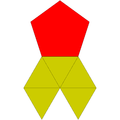
|
| Related regular polyhedra | ||
| Tetrahedron | Octahedron | Icosahedron |

|

|

|
Cupolae and rotunda
[edit]The next four Johnson solids are three cupolae and one rotunda. They represent sections of uniform polyhedra.
| Cupola | Rotunda | |||
|---|---|---|---|---|
| Uniform | J3 3c aC- | J4 4c | J5 5c | J6 5r aD- |
| Fastigium (Digonal cupola) (Triangular prism) |
Triangular cupola | Square cupola | Pentagonal cupola | Pentagonal rotunda |

|

|

|

|

|

|

|

|

| |
| Related uniform polyhedra | ||||
| Cuboctahedron | Rhombicuboctahedron | Rhombicosidodecahedron | Icosidodecahedron | |

|

|

|

| |
Modified pyramids
[edit]Johnson solids 7 to 17 are derived from pyramids.
Elongated and gyroelongated pyramids
[edit]In the gyroelongated triangular pyramid, three pairs of adjacent triangles are coplanar and form non-square rhombi, so it is not a Johnson solid.
| Elongated pyramids | Gyroelongated pyramids | ||||
|---|---|---|---|---|---|
| J7 3=> | J8 4=> | J9 5=> | Coplanar | J10 4z> | J11 5z> I- |
| Elongated triangular pyramid | Elongated square pyramid | Elongated pentagonal pyramid | Gyroelongated triangular pyramid (diminished trigonal trapezohedron) |
Gyroelongated square pyramid | Gyroelongated pentagonal pyramid |

|

|

|

|

|

|

|

|

|

|

| |
| Augmented from polyhedra | |||||
| tetrahedron triangular prism |
square pyramid cube |
pentagonal pyramid pentagonal prism |
tetrahedron octahedron |
square pyramid square antiprism |
pentagonal pyramid pentagonal antiprism |
Bipyramids
[edit]The square bipyramid is the regular octahedron, while the gyroelongated pentagonal bipyramid is the regular icosahedron, so they are not Johnson solids. In the gyroelongated triangular bipyramid, six pairs of adjacent triangles are coplanar and form non-square rhombi, so it is also not a Johnson solid.
| Bipyramids | Elongated bipyramids | Gyroelongated bipyramids | ||||||
|---|---|---|---|---|---|---|---|---|
| J12 3<> | Regular | J13 5<> | J14 3<=> | J15 4<=> | J16 5<=> | Coplanar | J17 4<z> | Regular |
| Triangular bipyramid | Square bipyramid (octahedron) |
Pentagonal bipyramid | Elongated triangular bipyramid | Elongated square bipyramid | Elongated pentagonal bipyramid | Gyroelongated triangular bipyramid (trigonal trapezohedron) |
Gyroelongated square bipyramid | Gyroelongated pentagonal bipyramid (icosahedron) |

|

|

|

|

|

|

|

|

|

|

|

|

|

|

|

|
||
| Augmented from polyhedra | ||||||||
| tetrahedron | square pyramid | pentagonal pyramid | tetrahedron triangular prism |
square pyramid cube |
pentagonal pyramid pentagonal prism |
tetrahedron Octahedron |
square pyramid square antiprism |
pentagonal pyramid pentagonal antiprism |
Modified cupolae and rotundas
[edit]Johnson solids 18 to 48 are derived from cupolae and rotundas.
Elongated and gyroelongated cupolae and rotundas
[edit]| Elongated cupola | Elongated rotunda | Gyroelongated cupola | Gyroelongated rotunda | ||||||
|---|---|---|---|---|---|---|---|---|---|
| Coplanar | J18 3c= | J19 4c= eC- | J20 5c= | J21 5r= | Concave | J22 3cz | J23 4cz | J24 5cz | J25 5rz |
| Elongated fastigium | Elongated triangular cupola | Elongated square cupola | Elongated pentagonal cupola | Elongated pentagonal rotunda | Gyroelongated fastigium | Gyroelongated triangular cupola | Gyroelongated square cupola | Gyroelongated pentagonal cupola | Gyroelongated pentagonal rotunda |

|

|

|

|

|

|

|

|

|

|

|

|

|

|

|

|

|

| ||
| Augmented from polyhedra | |||||||||
| Square prism Triangular prism |
Hexagonal prism Triangular cupola |
Octagonal prism Square cupola |
Decagonal prism Pentagonal cupola |
Decagonal prism Pentagonal rotunda |
square antiprism Triangular prism |
Hexagonal antiprism Triangular cupola |
Octagonal antiprism Square cupola |
Decagonal antiprism Pentagonal cupola |
Decagonal antiprism Pentagonal rotunda |
Bicupolae
[edit]The triangular gyrobicupola is an Archimedean solid (in this case the cuboctahedron), so it is not a Johnson solid. In the orthobifastigum,two pairs of triangles form non-square rhombi, so it is not a Johnson solid.
| Orthobicupola | Gyrobicupola | ||||||
|---|---|---|---|---|---|---|---|
| Coplanar | J27 3cc | J28 4cc | J30 5cc | J26 2cc* | Semiregular | J29 4cc* | J31 5cc* |
| Orthobifastigium | Triangular orthobicupola | Square orthobicupola | Pentagonal orthobicupola | Gyrobifastigium | Triangular gyrobicupola (cuboctahedron) |
Square gyrobicupola | Pentagonal gyrobicupola |

|

|

|

|

|

|
||

|

|

|

|

|

|

| |
| Augmented from polyhedron | |||||||
| Triangular prism | Triangular cupola | Square cupola | Pentagonal cupola | Triangular prism | Triangular cupola | Square cupola | Pentagonal cupola |
Cupola-rotundas and birotundas
[edit]The pentagonal gyrobirotunda is an Archimedean solid (in this case the icosidodecahedron), so it is not a Johnson solid.
| Cupola-rotunda | Birotunda | ||
|---|---|---|---|
| J32 5cr | J33 5cr* | J34 5rr aD* | Semiregular |
| Pentagonal orthocupolarotunda | Pentagonal gyrocupolarotunda | Pentagonal orthobirotunda | Pentagonal gyrobirotunda (icosidodecahedron) |

|

|

|

|

|

|

|

|
| Augmented from polyhedra | |||
| Pentagonal cupola Pentagonal rotunda |
Pentagonal rotunda | ||
Elongated bicupolae
[edit]The elongated square orthobicupola is an Archimedean solid (in this case the rhombicuboctahedron), so it is not a Johnson solid.
| Elongated orthobicupola | Elongated gyrobicupola | ||||||
|---|---|---|---|---|---|---|---|
| Coplanar | J35 3c=c | Semiregular | J38 5c=c | Coplanar | J36 3c=c* | J37 4c=c* eC* | J39 5c=c* |
| Elongated orthobifastigium | Elongated triangular orthobicupola | Elongated square orthobicupola (rhombicuboctahedron) |
Elongated pentagonal orthobicupola | Elongated gyrobifastigium | Elongated triangular gyrobicupola | Elongated square gyrobicupola | Elongated pentagonal gyrobicupola |

|

|

|

|

|

|

|

|

|

|

|

|

|

| ||
| Augmented from polyhedra | |||||||
| Square prism Triangular prism |
Hexagonal prism Triangular cupola |
Octagonal prism Square cupola |
Decagonal prism Pentagonal cupola |
Square prism Triangular prism |
Hexagonal prism Triangular cupola |
Octagonal prism Square cupola |
Decagonal prism Pentagonal cupola |
Elongated cupola-rotundas and birotundas
[edit]| Elongated cupola-rotunda | Elongated birotunda | ||
|---|---|---|---|
| J40 5c=r | J41 5c=r* | J42 5r=r | J43 5r=r* |
| Elongated pentagonal orthocupolarotunda | Elongated pentagonal gyrocupolarotunda | Elongated pentagonal orthobirotunda | Elongated pentagonal gyrobirotunda |

|

|

|

|

|

|

|

|
| Augmented from polyhedra | |||
| Decagonal prism Pentagonal cupola Pentagonal rotunda |
Decagonal prism Pentagonal rotunda | ||
Gyroelongated bicupolae, cupola-rotundas, and birotundas
[edit]These Johnson solids have 2 chiral forms.
| Gyroelongated bicupola | Gyroelongated cupola-rotunda | Gyroelongated birotunda | |||
|---|---|---|---|---|---|
| Concave | J44 3czc | J45 4czc | J46 5czc | J47 5czr | J48 5rzr |
| Gyroelongated bifastigium | Gyroelongated triangular bicupola | Gyroelongated square bicupola | Gyroelongated pentagonal bicupola | Gyroelongated pentagonal cupolarotunda | Gyroelongated pentagonal birotunda |

|

|

|

|

|

|

|

|

|

|

| |
| Augmented from polyhedra | |||||
| Triangular prism Square antiprism |
Triangular cupola Hexagonal antiprism |
Square cupola Octagonal antiprism |
Pentagonal cupola Decagonal antiprism |
Pentagonal cupola Pentagonal rotunda Decagonal antiprism |
Pentagonal rotunda Decagonal antiprism |
Augmented prisms
[edit]Johnson solids 49 to 57 are built by augmenting the sides of prisms with square pyramids.
| Augmented triangular prisms | Augmented pentagonal prisms | Augmented hexagonal prisms | ||||||
|---|---|---|---|---|---|---|---|---|
| J49 3=+ | J50 3=++ | J51 3=+++ | J52 5=+ | J53 5=++ | J54 6=+ | J55 6=++ | J56 6=+x | J57 6=+++ |
| Augmented triangular prism | Biaugmented triangular prism | Triaugmented triangular prism | Augmented pentagonal prism | Biaugmented pentagonal prism | Augmented hexagonal prism | Parabiaugmented hexagonal prism | Metabiaugmented hexagonal prism | Triaugmented hexagonal prism |

|

|

|

|

|

|

|

|

|

|

|

|

|

|

|

|

|

|
| Augmented from polyhedra | ||||||||
| Triangular prism Square pyramid |
Pentagonal prism Square pyramid |
Hexagonal prism Square pyramid | ||||||
J8 and J15 would also fit here, as an augmented square prism and biaugmented square prism.
Modified Platonic solids
[edit]Johnson solids 58 to 64 are built by augmenting or diminishing Platonic solids.
Augmented dodecahedra
[edit]| J58 D+ | J59 D++ | J60 D+x | J61 D+++ |
|---|---|---|---|
| Augmented dodecahedron | Parabiaugmented dodecahedron | Metabiaugmented dodecahedron | Triaugmented dodecahedron |

|

|

|

|

|

|

|

|
| Augmented from polyhedra | |||
| Dodecahedron and pentagonal pyramid | |||
Diminished and augmented diminished icosahedra
[edit]| Diminished icosahedron | Augmented tridiminished icosahedron | |||
|---|---|---|---|---|
| J11 (Repeated) |
Uniform | J62 I-/ | J63 I--- | J64 I---+ |
| Diminished icosahedron (Gyroelongated pentagonal pyramid) |
Parabidiminished icosahedron (Pentagonal antiprism) |
Metabidiminished icosahedron | Tridiminished icosahedron | Augmented tridiminished icosahedron |

|

|

|

|

|

|

|

|

| |
Modified Archimedean solids
[edit]Johnson solids 65 to 83 are built by augmenting, diminishing or gyrating Archimedean solids.
Augmented Archimedean solids
[edit]| Augmented truncated tetrahedron | Augmented truncated cubes | Augmented truncated dodecahedra | ||||
|---|---|---|---|---|---|---|
| J65 tT+ | J66 tC+ | J67 tC++ | J68 tD+ | J69 tD++ | J70 tD+x | J71 tD+++ |
| Augmented truncated tetrahedron | Augmented truncated cube | Biaugmented truncated cube | Augmented truncated dodecahedron | Parabiaugmented truncated dodecahedron | Metabiaugmented truncated dodecahedron | Triaugmented truncated dodecahedron |

|

|

|

|

|

|

|

|

|

|

|

|

|

|
| Augmented from polyhedra | ||||||
| truncated tetrahedron triangular cupola |
truncated cube square cupola |
truncated dodecahedron pentagonal cupola | ||||
Gyrate and diminished rhombicosidodecahedra
[edit]| Gyrate rhombicosidodecahedra | |||
|---|---|---|---|
| J72 eD* | J73 eD** | J74 eD*' | J75 eD*** |
| Gyrate rhombicosidodecahedron | Parabigyrate rhombicosidodecahedron | Metabigyrate rhombicosidodecahedron | Trigyrate rhombicosidodecahedron |

|

|

|

|

|

|

|

|
| Diminished rhombicosidodecahedra | |||
| J76 eD- | J80 eD-- | J81 eD-/ | J83 eD--- |
| Diminished rhombicosidodecahedron | Parabidiminished rhombicosidodecahedron | Metabidiminished rhombicosidodecahedron | Tridiminished rhombicosidodecahedron |

|

|

|

|

|

|

|

|
| Gyrate diminished rhombicosidodecahedra | |||
| J77 -* | J78 -' | J79 -** | J82 --* |
| Paragyrate diminished rhombicosidodecahedron | Metagyrate diminished rhombicosidodecahedron | Bigyrate diminished rhombicosidodecahedron | Gyrate bidiminished rhombicosidodecahedron |

|

|

|

|

|

|

|

|
J37 would also appear here as a duplicate (it is a gyrate rhombicuboctahedron).
Other gyrate and diminished archimedean solids
[edit]Other archimedean solids can be gyrated and diminished, but they all result in previously counted solids.
| J27 | J3 | J34 | J6 | J37 | J19 | Uniform |
|---|---|---|---|---|---|---|
| Gyrate cuboctahedron (triangular orthobicupola) |
Diminished cuboctahedron (triangular cupola) |
Gyrate icosidodecahedron (pentagonal orthobirotunda) |
Diminished icosidodecahedron (pentagonal rotunda) |
Gyrate rhombicuboctahedron (elongated square gyrobicupola) |
Diminished rhombicuboctahedron (elongated square cupola) |
Bidiminished rhombicuboctahedron (octagonal prism) |

|

|

|

|

|

|

|

|

|

|

|

|

|
|
| Gyrated or diminished from polyhedra | ||||||
| Cuboctahedron | Icosidodecahedron | Rhombicuboctahedron | ||||

|

|

| ||||
Elementary solids
[edit]Johnson solids 84 to 92 are not derived from "cut-and-paste" manipulations of uniform solids.
Snub antiprisms
[edit]The snub antiprisms can be constructed as an alternation of a truncated antiprism. The gyrobianticupolae are another construction for the snub antiprisms. Only snub antiprisms with at most 4 sides can be constructed from regular polygons. The snub triangular antiprism is the regular icosahedron, so it is not a Johnson solid.
| J84 | Regular | J85 |
|---|---|---|
| Snub disphenoid ss{2,4} |
Icosahedron ss{2,6} |
Snub square antiprism ss{2,8} |
| Digonal gyrobianticupola | Triangular gyrobianticupola | Square gyrobianticupola |

|

|

|

|

|

|
Others
[edit]| J86 | J87 | J88 | |
|---|---|---|---|
| Sphenocorona | Augmented sphenocorona | Sphenomegacorona | |

|

|

| |

|

|

| |
| J89 | J90 | J91 | J92 |
| Hebesphenomegacorona | Disphenocingulum | Bilunabirotunda | Triangular hebesphenorotunda |

|

|

|

|
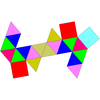
|

|

|

|
Classification by types of faces
[edit]Triangle-faced Johnson solids
[edit]Five Johnson solids are deltahedra, with all equilateral triangle faces:
Triangle and square-faced Johnson solids
[edit]Twenty four Johnson solids have only triangle or square faces:
Triangle and pentagon-faced Johnson solids
[edit]Eleven Johnson solids have only triangle and pentagon faces:
Triangle, square, and pentagon-faced Johnson solids
[edit]Twenty Johnson solids have only triangle, square, and pentagon faces:
Triangle, square, and hexagon-faced Johnson solids
[edit]Eight Johnson solids have only triangle, square, and hexagon faces:
Triangle, square, and octagon-faced Johnson solids
[edit]Five Johnson solids have only triangle, square, and octagon faces:
Triangle, pentagon, and decagon-faced Johnson solids
[edit]Two Johnson solids have only triangle, pentagon, and decagon faces:
Triangle, square, pentagon, and hexagon-faced Johnson solids
[edit]Only one Johnson solid has triangle, square, pentagon, and hexagon faces:
Triangle, square, pentagon, and decagon-faced Johnson solids
[edit]Sixteen Johnson solids have only triangle, square, pentagon, and decagon faces:
Circumscribable Johnson solids
[edit]25 of the Johnson solids have vertices that exist on the surface of a sphere: 1–6,11,19,27,34,37,62,63,72–83. All of them can be seen to be related to a regular or uniform polyhedra by gyration, diminishment, or dissection.[3]
| Octahedron | Cuboctahedron | Rhombicuboctahedron | |||
|---|---|---|---|---|---|
| J1 |
J3
|
J27
|
J4
|
J19
|
J37
|
| Icosahedron | Icosidodecahedron | ||||
|---|---|---|---|---|---|
| J2 |
J11
|
J62
|
J63
|
J6
|
J34
|
| Rhombicosidodecahedron | ||||||
|---|---|---|---|---|---|---|
J5
|
J72
|
J73
|
J74
|
J75
|
J76
|
J77
|
J78
|
J79
|
J80
|
J81
|
J82
|
J83
| |
See also
[edit]References
[edit]- Johnson, Norman W. (1966). "Convex Solids with Regular Faces". Canadian Journal of Mathematics. 18: 169–200. doi:10.4153/cjm-1966-021-8. ISSN 0008-414X. Zbl 0132.14603. Contains the original enumeration of the 92 solids and the conjecture that there are no others.
- Zalgaller, Victor A. (1967). "Convex Polyhedra with Regular Faces". Zap. Nauchn. Semin. Leningr. Otd. Mat. Inst. Steklova (in Russian). 2: 1–221. ISSN 0373-2703. Zbl 0165.56302. The first proof that there are only 92 Johnson solids. English translation: Zalgaller, Victor A. (1969). "Convex Polyhedra with Regular Faces". Seminars in Mathematics, V. A. Steklov Math. Inst., Leningrad. 2. Consultants Bureau. ISSN 0080-8873. Zbl 0177.24802.
- Anthony Pugh (1976). Polyhedra: A visual approach. California: University of California Press Berkeley. ISBN 0-520-03056-7. Chapter 3 Further Convex polyhedra
- Timofeenko, A.V. (2009). "The Non-Platonic and Non-Archimedean Noncomposite Polyhedra". J. Math. Sci. 162. 162 (5): 710–729. doi:10.1007/s10958-009-9655-0. [1]
olyhedra." J. Math. Sci. 162, 710-729, 2009.
- ^ GWH. "Pseudo Rhombicuboctahedra". www.georgehart.com. Retrieved 17 April 2018.
- ^ George Hart (quoting Johnson) (1996). "Johnson Solids". Virtual Polyhedra. Retrieved 5 February 2014.
- ^ Klitzing, Dr. Richard. "Johnson solids et al". bendwavy.org. Retrieved 17 April 2018.
External links
[edit]- Gagnon, Sylvain (1982). "Les polyèdres convexes aux faces régulières" [Convex polyhedra with regular faces] (PDF). Structural Topology (6): 83–95.
- Paper Models of Polyhedra Many links
- Johnson Solids by George W. Hart.
- Images of all 92 solids, categorized, on one page
- Weisstein, Eric W. "Johnson Solid". MathWorld.
- VRML models of Johnson Solids by Jim McNeill
- VRML models of Johnson Solids by Vladimir Bulatov
- CRF polychora discovery project attempts to discover CRF polychora Archived 2020-10-31 at the Wayback Machine (Convex 4-dimensional polytopes with Regular polygons as 2-dimensional Faces), a generalization of the Johnson solids to 4-dimensional space
- https://levskaya.github.io/polyhedronisme/ a generator of polyhedrons and Conway operations applied to them, including Johnson solids.
